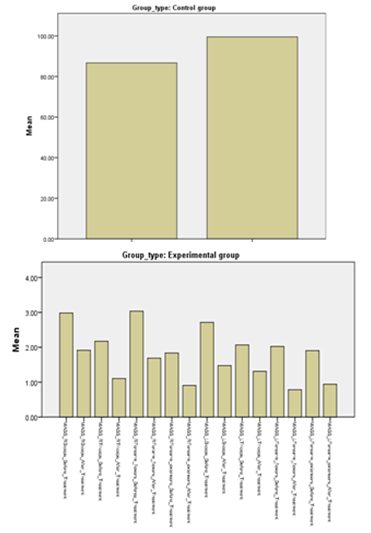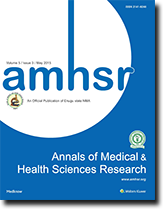Role of Exer-Games in Improving Motor Performance and Functional Independence of Upper Limb in Spastic Cerebral Palsy Children
2 Department of Physiotherapist, Riphah International University, Lahore, Pakistan, Email: naveed.anwar@uipt.uol.edu.pk
3 Department of Physiotherapist, Kanaan Physiotherapy & Spine Clinic, Lahore, Pakistan
4 Department of Physiotherapist, Fatima Memorial Medical & Dental College, Lahore, Pakistan
, DOI: 10.54608.annalsmedical.2021.11
Citation: Saghir M, et al. Role of Exer-Games in Improving Motor Performance and Functional Independence of Upper Limb in Spastic Cerebral Palsy Children. Ann Med Health Sci Res. 2021;11:1506-1511.
This open-access article is distributed under the terms of the Creative Commons Attribution Non-Commercial License (CC BY-NC) (http://creativecommons.org/licenses/by-nc/4.0/), which permits reuse, distribution and reproduction of the article, provided that the original work is properly cited and the reuse is restricted to noncommercial purposes. For commercial reuse, contact reprints@pulsus.com
Abstract
Objective: To determine role of Exer-gaming in improving motor performance and functional independence of upper limb in Spastic Cerebral Palsy (SCP) children.
Methods: A quasi experimental study was conducted in 58 patients, selected with convenience sampling according to set eligibility criteria. This was done in kanan physiotherapy spine and rehabilitation center. There were two groups. In experimental group Baseline treatment was given for 20 minutes then different games were incorporated like Wii tennis ball (10 minutes) Rest interval (5 minutes) and then in Dozo Quest (10 minutes). The control group was given conventional methods of treatment. The hallmark of conventional treatment will be stretching, strengthening, superficial transcutaneous nerve stimulator and electrical stimulation. This was a single blinded study in which accessor was blinded. Data were collected by independent assessment. The data was evaluated by IBM statistical package of social sciences version 20. The quantitative variables were presented as mean and standard deviation. For checking the normality in the data Kolmograph tests was used. Before/after comparisons was done using parametric methods. For within group Paired t test and between groups comparison independent t test was used.
Results: The results showed that experimental group showed more reduction in spasticity according to Modified Ashworth Scale (MAS) with p-value=0.00 than control group. The Gross Motor Function Measure (GMFM) showed better results in both groups with p-value=0.00. Conclusion: The study concluded that virtual reality exercises can affect the upper limb muscle tone and physical status of children with spastic cerebral palsy. The limitation of study was small sample size, Time period was short and there was difficulty in giving proper exercises to some patients.
Keywords
Cerebral palsy; Virtual reality exercises; Functional activities; Conservative exercises
Introduction
Cerebral Paralysis (CP) is the most broadly documented reason for physical incapacity influencing children in developed nations, with an occurrence of 2.0 to 2.5 for every 1000 live births. [1] Prevalence of CP is 2 to 3 per 1000 live births and there is dissension regarding the changes rate with time. [2] The risk of palsy increasing with following factors such as declining age at delivery, length of gestation, deprived intrauterine development and low birth weights so these children may be damaged before their birth so mostly. [3]
Children with Cerebral Paralysis (CP) have several neurological deficits that interfere with motor control and daily activities. These hindrances incorporate neuromuscular and musculoskeletal problems, for example, spasticity, muscle contractures, disco ordination, loss of particular motor control, and weakness. As the essential objective of therapeutic interventions [Figure 1] for youngsters with CP is to upgrade the child’s capacity to perform exercises with regards to everyday life, the connection between motor hindrance and useful movement has a significant effect on clinical practice. [4]
Physiotherapy, occupational therapy and speech therapy can help and elevate the status of CP children than any other regimens available to date [Table 1], and the treatment including this all known as conservative therapy for Cerebral Palsy patients. In the course of the most recent couple of years, Exer-Games has advanced as additional practice of restoration for Cerebral Palsy patients. [5]
| Group type | Experimental Group | Control group | |||
|---|---|---|---|---|---|
| Mean ± S.D | P-value | Mean ± S.D | P-value | ||
| Pair 1 | MASS_RBiceps_Before | 2.75 ± 0.87 | 0.16 | 2.86 ± 0.83 | 0.15 |
| MASS_RBiceps_After | 1.68 ± 0.54 | 0.1 | 2.48 ± 0.63 | 0.11 | |
| Pair 2 | MASS_RTriceps_Before | 1.75 ± 0.43 | 0.08 | 2.17 ± 0.71 | 0.13 |
| MASS_RTriceps_After | 0.68 ± 0.54 | 0.1 | 1.93 ± 0.52 | 0.09 | |
| Pair 3 | MASS_RForearm_flexors_Before | 2.55 ± 0.73 | 0.13 | 3.03 ± 0.42 | 0.07 |
| MASS_RForearm_flexors_After | 1.20 ± 0.67 | 0.12 | 2.65 ± 0.48 | 0.08 | |
| Pair 4 | MASS_RForearm_extensors_Before | 1.44 ± 0.73 | 0.13 | 1.82 ± 0.38 | 0.07 |
| MASS_RForearm_extensors_After | 0.51 ± 0.57 | 0.1 | 1.68 ± 0.47 | 0.08 | |
| Pair 5 | MASS_LBiceps_Before | 2.48 ± 0.87 | 0.16 | 2.79 ± 0.72 | 0.13 |
| MASS_LBiceps_After | 1.24 ± 0.73 | 0.13 | 1.86 ± 0.69 | 0.12 | |
| Pair 6 | MASS_LTriceps_Before | 1.86 ± 0.74 | 0.13 | 2.13 ± 0.91 | 0.16 |
| MASS_LTriceps_After | 1.10 ± 0.61 | 0.11 | 1.65 ± 0.81 | 0.15 | |
| Pair 7 | MASS_LForearm_flexors_Before | 2.20 ± 0.77 | 0.14 | 2.72 ± 0.45 | 0.08 |
| MASS_LForearm_flexors_After | 0.96 ± 0.73 | 0.13 | 2.20 ± 0.61 | 0.11 | |
| Pair 8 | MASS_LForearm_extensors_Before | 1.65 ± 0.85 | 0.15 | 1.93 ± 0.65 | 0.12 |
| MASS_LForearm_extensors_After | 0.68 ± 0.54 | 0.1 | 1.41 ± 0.68 | 0.12 | |
Table 1: Modified Ashworth Scale Score (MASS) before and after intervention.
The role of EG treatment method is to engage patients with selfreliance during motor activities by giving interactive tasks and interesting games with controlled conditions from easy level to hardest one. This games based environment is appealing for child to be habitual of this practice and this would be helping them to restore their functional status. [6] Once the child gain a particular target in exercise program, the game can be moved up to the next level of exertion, this is the way to improve the continuity and novelty of Exer-Game studies.
Exer-Games, or dynamic computer games, may give viable options in contrast to standard exercise to meet suggested physical movement levels and give encouraging feedback to proceed with physical activity [Table 2]. Exer-Games is very convenient support and treatment approach that assist patients in their health related matters of balance and coordination in posture of upper limb by giving them confidence. [7]
| Group type | Experimental Group | Control group | |||
|---|---|---|---|---|---|
| Mean ± S.D | P-value | Mean ± S.D | P-value | ||
| Pair 1 | MASS_RBiceps_Before-MASS_RBiceps_After | 1.06 ± 0.96 | 0 | 0.37 ± 0.77 | 0.014 |
| Pair 2 | MASS_RTriceps_Before-MASS_RTriceps_After | 1.06 ± 0.65 | 0 | 0.24 ± 0.73 | 0.09 |
| Pair 3 | MASS_RForearm_flexors_Before-MASS_RForearm_flexors_After | 1.34 ± 0.72 | 0 | 0.37 ± 0.56 | 0.001 |
| Pair 4 | MASS_RForearm_extensors_Before-MASS_RForearm_extensors_After | 0.93 ± 0.92 | 0 | 0.13 ± 0.63 | 0.255 |
| Pair 5 | MASS_LBiceps_Before-MASS_LBiceps_After | 1.24 ± 0.91 | 0 | 0.93 ± 0.70 | 0 |
| Pair 6 | MASS_LTriceps_Before- MASS_LTriceps_After | 0.75 ± 0.78 | 0 | 0.48 ± 0.63 | 0 |
| Pair 7 | MASS_LForearm_flexors_Before-MASS_LForearm_flexors_After | 1.24 ± 0.57 | 0 | 0.51 ± 0.57 | 0 |
| Pair 8 | MASS_LForearm_extensors_Before-MASS_LForearm_extensors _After | 0.96 ± 1.14 | 0 | 0.51 ± 0.82 | 0.002 |
Table 2: Modified ashworth scale score before and after intervention paired t-test.
Materials and Methods
Study design
Quasi Experimental Study design
Setting
Study was held in Kanan physiotherapy and spine clinic.
Duration of the study
Study was completed in duration of six months. The time taken in synopsis approval was excluded in this total duration.
Sample size
The sample size estimated to be 58 as per following details calculated with EpiTool, divided in to two groups
Group A=29
Group B=29
n=(Z2-P(1-P))/e2
Z=value standard normal distribution to desired confidence level
(Z=1.96 for 95% CI)
P is true proportion as expected
e is precision level (half desired Coefficient Interval), while tentative population size visiting study setting to be 70.
Sampling techniques
Convenience sampling technique
Sample selection
Inclusion criteria:
• Children with spastic cerebral palsy ranging from 11 years-15 years of either gender, having Gross motor function scale score of Grade III-IV [Table 3].
| Group type | Mean ± S.D | P-value | |
|---|---|---|---|
| A | GMFM_Before – | -15.86 ± 10.16 | 0 |
| GMFM_After | |||
| B | GMFM_Before – | -12.82 ± 7.85 | 0 |
| GMFM_After | |||
Exclusion criteria:
• The children with spastic cerebral palsy having co-morbid conditions and contractures that can interfere.
• The children having respiratory and cardiac complications.
• The children having severe mental retardation because of difficulty in understanding commands.
• Any red flag signs (tumor, fracture, metabolic diseases, prolong history of steroidal use.
• Individuals who are on regular use of analgesic medications
Intervention
Experimental group A: Different games were used
Baseline treatment (20 minutes)
Wii tennis ball (10 minutes)
Rest interval (5 minutes)
In Dozo Quest (10 minutes)
The experimental group was treated with protocol as per given in Control Group as conventional methods of treatment for spastic cerebral palsy as per stated in literature. The hallmark of conventional treatment was stretching, strengthening, superficial transcutaneous nerve stimulator and electrical stimulation. [8-10]
Control group B:
The control group was given conventional methods of treatment for spastic cerebral palsy as per stated in literature. The hallmark of conventional treatment was stretching, strengthening, superficial transcutaneous nerve stimulator and electrical stimulation. [8-10]
Data Collection/Assessment
Data were collected by independent accessor who was experienced in out coming measures [Figure 2]. Data were collected at base measurements means in initial stages then it is collected after 3 weeks and then finally after 6 weeks.
Outcome measures
1. Gross Motor Function Measure. [11]
2. Modified ashworth scale.
Data analysis
The data was analyzed by using SPSS 20, Statistical Package for Social Sciences. The demographics were presented in frequency/ percentage or mean standard deviation, according to type of variable i.e. categorical or continuous respectively.
Inferential statistics included paired samples T test for comparisons of means between two groups and comparisons of means at pre/post intervals of measurements within each group separately and we used independent t-test to compare between 2 different groups.
Approval for ethical review
The study was approved from ethical review committee of Riphah College of Rehab Sciences, Lahore. Patients/ Parents/ Guardians were taken informed consent before participation in study conducting in Kanan physiotherapy and spine clinic.
Results
The study demographics showed that an average age of participants is 12.70 ± 1.33 in years with ranging from 11 years-15 years old children for both experiment and control groups. Out of 58 participants, 34 are males and 24 females with spastic cerebral palsy.
The main outcome measure of this study is Modified Ashworth Scale (MAS) for spasticity. According to the results, the average spasticity score of upper limb muscles for experimental group (group A) before the intervention was as; right biceps=2.75 ± 0.87, left biceps=2.48 ± 0.87, right triceps=1.75 ± 0.43, left triceps=1.86 ± 0.74, right forearm flexors=2.55 ± 0.73, left forearm flexors=2.20 ± 0.77, right forearm extensors=1.44 ± 0.73 and left forearm extensors=1.65 ± 0.85. And after applying Intervention of Exer gaming 6 weeks, it was changed to right biceps=1.68 ± 0.54, left biceps=1.24 ± 0.73, right triceps=0.68 ± 0.54, left triceps=1.10 ± 0.61, right forearm flexors=1.20 ± 0.67, left forearm flexors=0.96 ± 0.73, right forearm extensors=0.51 ± 0.57 and left forearm extensors=0.68 ± 0.54 respectively
For control group (group B), the average spasticity score of upper limb muscles before the intervention was as; right biceps=2.86 ± 0.83, left biceps=2.79 ± 0.72, right triceps=2.17 ± 0.71, left triceps=2.13 ± 0.91, right forearm flexors=3.03 ± 0.42, left forearm flexors=2.72 ± 0.45, right forearm extensors=1.82 ± 0.38 and left forearm extensors=1.93 ± 0.65. And after applying Intervention of 6 weeks, it was changed to right biceps=2.48 ± 0.63, left biceps=1.86 ± 0.69, right triceps=1.93 ± 0.52, left triceps=1.65 ± 0.81, right forearm flexors=2.65 ± 0.48, left forearm flexors=2.20 ± 0.61, right forearm extensors=1.68 ± 0.47 and left forearm extensors=1.41 ± 0.68 respectively
The spasticity of an experimental group showed p-value=0.00 for all the muscles after applying Intervention while control group showed p-value=0.01 for right biceps, p=0.09 for right triceps, p=0.00 for right forearm flexors, p=0.25 for right forearm extensors, p=0.00 for left biceps, p=0.00 for left triceps, p=0.00 for left forearm flexors, and p=0.00 for left forearm extensors respectively
The functional status is examined through Gross Motor Function Measure scale (GMFM-88). According to the results, the average GMFM scale score for experimental group (group A) before the intervention was 85.48 ± 8.44 that was changed to 101.34 ± 11.37 after 6 weeks EG Intervention. While for control group (group B), the average GMFM scale score before the intervention was 85.68 ± 9.82 that was changed to 99.51 ± 10.75 after 6 weeks conservative Intervention as shown in Table 4. The p-value for functional status measure after 6-week Intervention is 0.00 for both experimental and control group respectively.
Discussion
The study investigates the effect of virtual reality gaming for decreasing spasticity and improving functional status after spastic cerebral palsy. With the conservative exercises and Exergaming exercises were applied after baseline assessment to the children with age range of 11 years-15 years.
This study higher rate of spastic cerebral palsy among male gender (n=34 or 58.6%) than female (n=24 or 41.4%). The spasticity recorded through MAS showed more improvement in experimental group (group A) which underwent through gaming exercises for all the included muscles of upper limb (p=0.00) than control group (group B) which is significant and justify the effect of virtual reality gaming on spasticity improvement. While control group showed significant p-value for some muscles except right triceps (p=0.09) and right forearm extensors (p=0.25) after 6-week intervention. The reliability of Modified Ashworth Scale depicts its usage for recording the spasticity. [12]
The functional status is examined through Gross Motor Function Measure scale (GMFM). According to the results, the average GMFM scale score for experimental group (group A) before the intervention was 85.48 ± 8.44 that was changed to 101.34 ± 11.37 after 6 weeks Exer-game Intervention. While for control group (group B), the average GMFM scale score before the intervention was 85.68 ± 9.82 that was changed to 99.51 ± 10.75 after 6 weeks conservative Intervention as shown in Table 4. The p-value for functional status measure after 6-week Intervention is 0.00 for both experimental and control group respectively.
| Group type | Mean | N | Std. Deviation | Std. Error Mean | ||
|---|---|---|---|---|---|---|
| A | Pair 1 | GMFM_Before | 85.4828 | 29 | 8.44994 | 1.56911 |
| GMFM_After | 101.3448 | 29 | 11.37125 | 2.11159 | ||
| B | Pair 1 | GMFM_Before | 86.6897 | 29 | 9.82382 | 1.82424 |
| GMFM_After | 99.5172 | 29 | 10.75248 | 1.99668 | ||
Table 4: GMFS between group analysis independent t test.
Meta-analytic evidence suggests that virtual environments are beneficial for rehabilitation, through demonstrated effectiveness over conventional therapy or no therapy for improving upper limb and daily living function, [13] and equivalent to or greater than conventional therapy across the full range of outcome levels including anatomical patho physiology, limited mobility and lack of confidence, in domains, such as balance and mobility, function of arm and activities of daily living. [14]
EG is now popular with Nintendo Wii™, Sony Play Station™, and Microsoft Xbox™ the way in discovering innovative technologies that make VR more and more “real.” The potential results of this VR system are evident but still literature is lacking for supporting new different ideas. [15]
VR rehabilitation has best results for active learning and complete participation of the children with CP as in different therapies thy may lose interest and it may affect outcomes. It is more safe and easy to do technology with no documented side effects so far [Table 5]. Various provocations can be considered, it has different levels of difficulty to control the ability of patients to improve, very friendly to therapists to design the relevant protocol specific individual to individual. Those children with CP having no compatibility with conventional and showing no benefits from conservative interventions, considered to undergo in this modern technology protocol for their rehabilitation. [6]
| Independent T-test | Mean ± S.D | P-Value |
|---|---|---|
| MASS_RBiceps | 1.68 ± 0.15 | 0 |
| MASS_RTricpes | 2.48 ± 0.54 | 0 |
| MASS_RForarm_flexors | 0.68 ± 0.63 | 0 |
| MASS_RForearm_extensors | 1.93 ± 0.54 | 0 |
| MASS_LBiceps | 1.20 ± 0.52 | 0.002 |
| MASS_LTricpes | 2.65 ± 0.67 | 0.005 |
| MASS_LForearm_flexors | 0.51 ± 0.48 | 0 |
| MASS_LForearm_extensors | 1.68 ± 0.57 | 0 |
Table 5: Modified Ashworth Scale Score (MASS) Gross Motor Function Measure (GMFM) after intervention independent t-test.
It is documented, [16] sometime, in children with spastic hemiplegic CP, VR is not beneficial on balance assessment scale with traditional exercise addition too. This result was obtained from all available outcomes from intervention group supplied VR therapy with addition of conservative treatment. The control group received alone traditional therapy that is not ethical and this study design has a question mark. So the worth of this finding is not convincible. While in rehabilitation of CP child the paramount under consideration are posture and balance control.
Earlier studies proved that Wii-based therapy produced significant outcomes with improvements in this field. [17,18] A research study was done in which CP children experienced 5 week program of Nintendo Wii games and then were same children given conservative program and in results it was clearly shown that balance got improved. [19]
None of the test for balance showed significant improvement with EG based therapy.
A study was done by Jelsma et al. [16] and they found out that balance got improved after nintendowii games in spastic cp children and a conflict could be seen because Nintendo Wii improve balance while our study gave more focus on upper limb movements even the child was not able to stand properly. [16-19]
Conclusion
The study concluded that virtual reality can affect the upper limb muscle tone and physical status of spastic cerebral palsy children. Both study groups showed improvement, but experimental group has more improvement in terms of spasticity and gross motor functions.
Acknowledgement
I am very much obliged to all my teachers and friends who have been a great source of inspiration in guiding me to undertake the title and activities of the research project. I am thankful to the patients for their co-operation and granting me the permission to study them and use their data for my report.
Disclaimer
This manuscript has not been previously published anywhere.
Conflict of Interest
There was no conflict of interest among authors.
Funding Disclosure
No funding source. It was self-funded project.
REFERENCES
- Bonnechere B, Jansen B, Omelina L, Van Sint Jan S. The use of commercial video games in rehabilitation: A systematic review. Int J Rehabil Res. 2016;39:277-290.
- Hernandez HA, Khan A, Fay L, Roy JS, Biddiss E. Force resistance training in hand grasp and arm therapy: Feasibility of a low-cost videogame controller. Games Health J. 2018;7:277-287.
- Hickman R, Popescu L, Manzanares R, Morris B, Lee SP, Dufek JS. Use of active video gaming in children with neuromotor dysfunction: A systematic review. Dev Med Child Neurol. 2017;59:903-911.
- Hsieh HC. Effects of a gaming platform on balance training for children with cerebral palsy. Pediatr Phys Ther. 2018;6:521.
- Parsons TD, Rizzo AA, Rogers S, York P. Virtual reality in paediatric rehabilitation: A review. Dev Neurorehabil. 2009;12:224-238.
- Harris K, Reid D. The influence of virtual reality play on children's motivation. Can J OccupTher. 2005;72:21-29.
- Velasco MA, Raya R, Muzzioli L, Morelli D, Otero A, Iosa M, et al. Evaluation of cervical posture improvement of children with cerebral palsy after physical therapy based on head movements and serious games. Biomed Eng Online. 2017;16:017-0364.
- Gupta SS. A randomized comparison of effectiveness of constraint-induced movement therapy versus conventional physiotherapy on upper-extremity dysfunction in treatment of hemiplegic cerebral palsy. Indian J PhysiotherOccupTher. 2015;2:20-24.
- Pool D, Elliott C, Bear N, Donnelly CJ, Davis C, Stannage K, et al. Neuromuscular electrical stimulation assisted gait increases muscle strength and volume in children with unilateral spastic cerebral palsy. Dev Med Child Neurol. 2016;58:492-501.
- Shin JW, Song GB, Hwangbo G. Effects of conventional neurological treatment and a virtual reality training program on eye-hand coordination in children with cerebral palsy. J PhysTher. 2015;27:2151-2154.
- Salavati M, Krijnen W, Rameckers E, Looijestijn P, Maathuis C, van der Schans C, et al. Reliability of the modified Gross Motor Function Measure-88 (GMFM-88) for children with both spastic cerebral palsy and cerebral visual impairment: A preliminary study. Res Dev Disabil. 2015;45:32-48.
- Mutlu A, Livanelioglu A, Gunel MK. Reliability of ashworth and modified ashworth scales in children with spastic cerebral palsy. BMC Musculoskelet Disord. 2008;9:44.
- Laver K, George S, Thomas S, Deutsch J, Crotty M. Virtual reality for stroke rehabilitation: An abridged version of a Cochrane review. Eur J Phys Rehabil Med. 2015;51:497-506.
- Lohse KR, Hilderman CG, Cheung KL, Tatla S, Van der Loos HM. Virtual reality therapy for adults post-stroke: a systematic review and meta-analysis exploring virtual environments and commercial games in therapy. PloS one. 2014;9:e93318.
- Snider L, Majnemer A, Darsaklis V. Virtual reality as a therapeutic modality for children with cerebral palsy. Dev Neurorehabil. 2010;13:120-128.
- Jelsma J, Pronk M, Ferguson G, Jelsma-Smit D. The effect of the nintendowii fit on balance control and gross motor function of children with spastic hemiplegic cerebral palsy. Dev Neurorehabil. 2013;16:27-37.
- Tarakci D, Ozdincler AR, Tarakci E, Tutuncuoglu F, Ozmen M. Wii-based balance therapy to improve balance function of children with cerebral palsy: A pilot study. J Phys Ther Sci. 2013;25:1123-1127.
- AlSaif AA, Alsenany S. Effects of interactive games on motor performance in children with spastic cerebral palsy. J Phys Ther Sci. 2015;27:2001-2003.
- Ramstrand N, Lygnegård F. Can balance in children with cerebral palsy improve through use of an activity promoting computer game? Technology and Health Care. 2012;20:531-540





 The Annals of Medical and Health Sciences Research is a monthly multidisciplinary medical journal.
The Annals of Medical and Health Sciences Research is a monthly multidisciplinary medical journal.